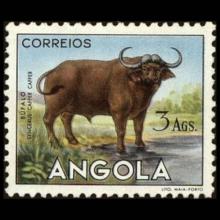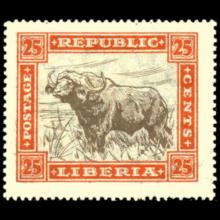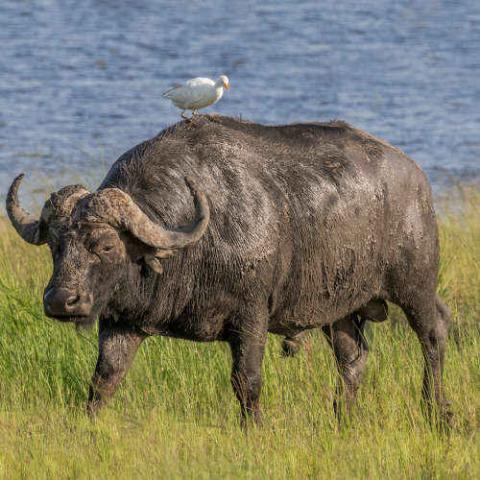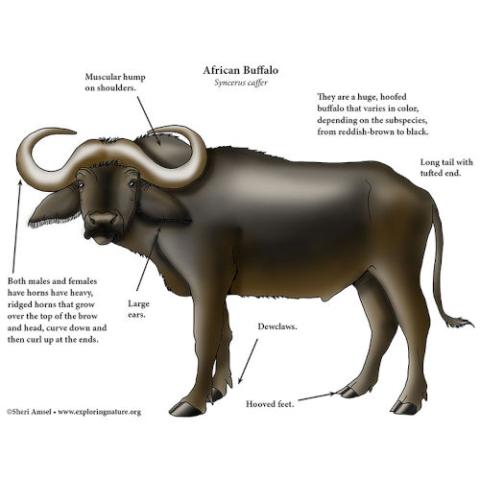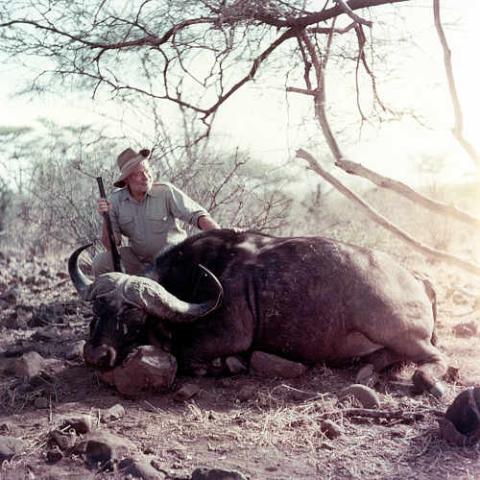NAMES
TAXONOMY
Angola
Issued:
Stamp:
Syncerus caffer
Liberia
Issued:
Stamp:
Syncerus caffer
Angola
Issued:
Stamp:
Syncerus caffer
Liberia
Issued:
Stamp:
Syncerus caffer
Angola
Issued:
Stamp:
Syncerus caffer
Liberia
Issued:
Stamp:
Syncerus caffer
Genus species (Animalia): Syncerus caffer
The African buffalo (Syncerus caffer) is a large sub-Saharan African bovine. There are five subspecies that are recognized as being valid. Syncerus caffer caffer, the Cape buffalo, is the nominotypical subspecies, and the largest one, found in Southern Africa and East Africa. S. c. nanus (the forest buffalo) is the smallest subspecies, common in forest areas of Central Africa and West Africa, while S. c. brachyceros is in West Africa and S. c. aequinoctialis is in the savannas of East Africa. The adult African buffalo's horns are its characteristic feature: they have fused bases, forming a continuous bone shield across the top of the head, referred to as a "boss".
The African buffalo is more closely related to other buffalo species than it is to other bovids such as American bison or domestic cattle, with its closest living relative being the Asian water buffalo. Its unpredictable temperament may be part of the reason that the African buffalo has never been domesticated, which would also explain why the African buffalo has no domesticated descendants, unlike the wild yak and wild water buffalo which are the ancestors of the domestic yak and water buffalo. Natural predators of adult African buffaloes include lions, African wild dogs, spotted hyenas, and Nile crocodiles. As one of the Big Five game animals, the Cape buffalo is a sought-after trophy in hunting.
Description
Unlike other large bovines, African buffalo have 52 chromosomes (for comparison, American bison and domestic cattle have 60). This means domestic cattle and bison are unable to create hybrid offspring with cape buffalo.
Relationship with humans
Status
The current status of the African buffalo is dependent on the animal's value to both trophy hunters and tourists, paving the way for conservation efforts through anti-poaching patrols, village crop damage payouts, and CAMPFIRE payback programs to local areas.
The African buffalo is listed as Near threatened by the IUCN, with a decreasing population of 400,000 individuals. While some populations (subspecies) are decreasing, others will remain unchanged in the long term if large, healthy populations continue to persist in a substantial number of national parks, equivalent reserves and hunting zones in southern and eastern Africa."
In the most recent and available census data at continental scale, the total estimated numbers of the three savanna-type African buffalo subspecies (S. c. caffer, S. c. brachyceros and S. c. aequinoctialis) are at 513,000 individuals.
In the past, numbers of African buffaloes suffered their most severe collapse during the great rinderpest epidemic of the 1890s, which, coupled with pleuro-pneumonia, caused mortalities as high as 95% among livestock and wild ungulates.
Being a member of the big five game group, a term originally used to describe the five most dangerous animals to hunt, the Cape buffalo is a sought-after trophy, with some hunters paying over $10,000 for the opportunity to hunt one. The larger bulls are targeted for their trophy value, although in some areas, buffaloes are still hunted for meat.
Attacks
One of the "big five" African game, it is known as "the Black Death" or "the widowmaker", and is widely regarded as a very dangerous animal. African buffaloes are sometimes reported to kill more people in Africa than any other animal, although the same claim is also made of hippopotamuses and crocodiles. These numbers may be somewhat overestimated; for example, in the country of Mozambique, attacks, especially fatal ones, were much less frequent on humans than those by hippos, and especially, Nile crocodiles. In Uganda, on the other hand, large herbivores were found to attack more people on average than lions or leopards and have a higher rate of inflicting fatalities during attacks than the predators (the African buffalo, in particular, killing humans in 49.5% of attacks on them), but hippos and even elephants may still kill more people per annum than buffaloes. African buffaloes are notorious among big-game hunters as very dangerous animals, with wounded animals reported to ambush and attack pursuers.
Reference: Wikipedia
Photos: Wikipedia Commons (Charles J. Sharp), Wildlife Vagabond (Håvard Rosenlund), exploringnature.org (Sheri Amsel)

